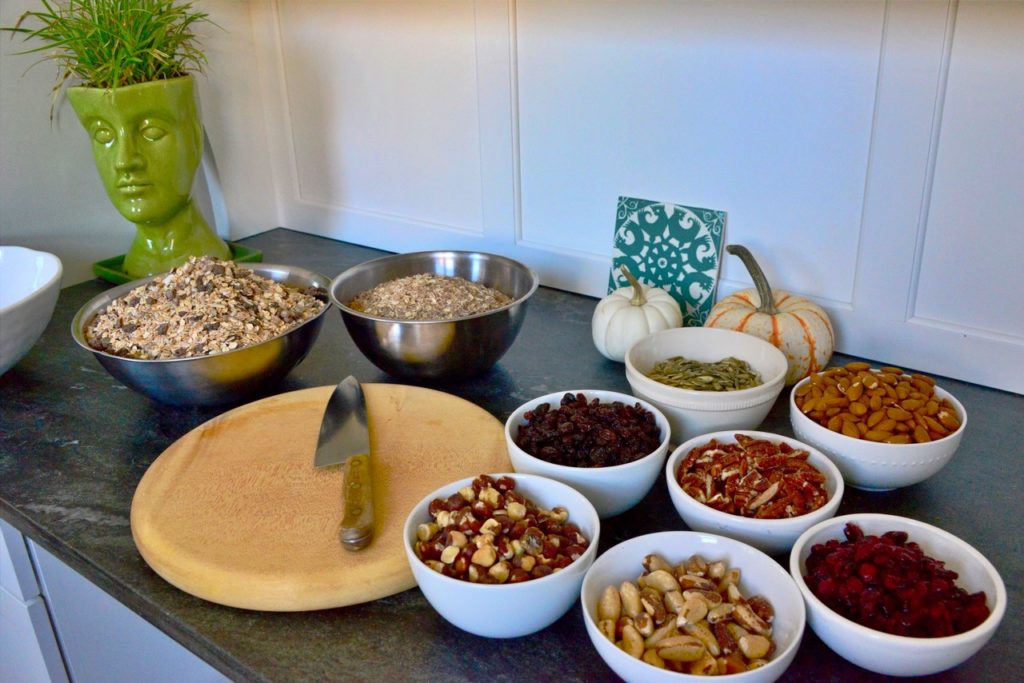Oxidation Is Killing Us. Antioxidants in Foods Can Neutralize the Free Radicals Causing Aging and Disease
Antioxidants in foods such as HealthSpan muesli can slow aging and disease
There’s a lot of talk – including on these pages! – about the way free radicals age us and promote disease, and even more about the power of certain foods to prevent this damage. So here is an explanation of where free radicals come from, how food can neutralize them and how we can assess the antioxidant capacity of different nutrients.
Thousands of phytonutrients, compounds made by plants that have the ability to neutralize free radicals, have emerged in the last two or three decades. Links have also been established between eating particular foods, the absorption of these antioxidant compounds, and tangible benefits to health.
However, the many tiny differences in the chemical structure of phytonutrients, their myriad combinations in plants, and varying biological activity in organisms, makes investigating them complex. A significant part of the research has been sponsored by well-financed companies with a lot to gain from promoting various different foods, adding a further complication to understanding their importance.
Also, because free radicals are an inevitable part of life for organisms such as us who are exposed to and rely on oxygen for survival, we have evolved with a complex system to protect us from the damage they can do. The emerging role of phytonutrients in the diet must be set against the several enzymes which routinely neutralize free radicals on a vast, industrial, scale.
Toxic free radicals damage our cells, increasing our risk of disease
First the very basic biochemistry. Free radicals are molecules, often tiny ones of only a couple of atoms, carrying an extra electron or with one missing. They are unstable and highly reactive, with considerable power to take or donate an electron to regain a balanced charge. The molecules they damage may themselves be made into free radicals, setting off a chain reaction.
One important source of free radicals is as a natural byproduct of the energy generating activity of mitochondria in cells. Another is white blood cells such as macrophages which use “radical oxygen species” (ROS) such as the superoxide anion and hydroxyl radical to kill infectious organisms, at the expense of releasing these dangerous molecules into the body. Even the process of digesting food or exercising produces these reactive molecules. Our external environment also promotes the production of free radicals – ultraviolet light from the sun, environmental pollution including cigarette smoke, and radiation from X-rays at the airport or during medical scans.
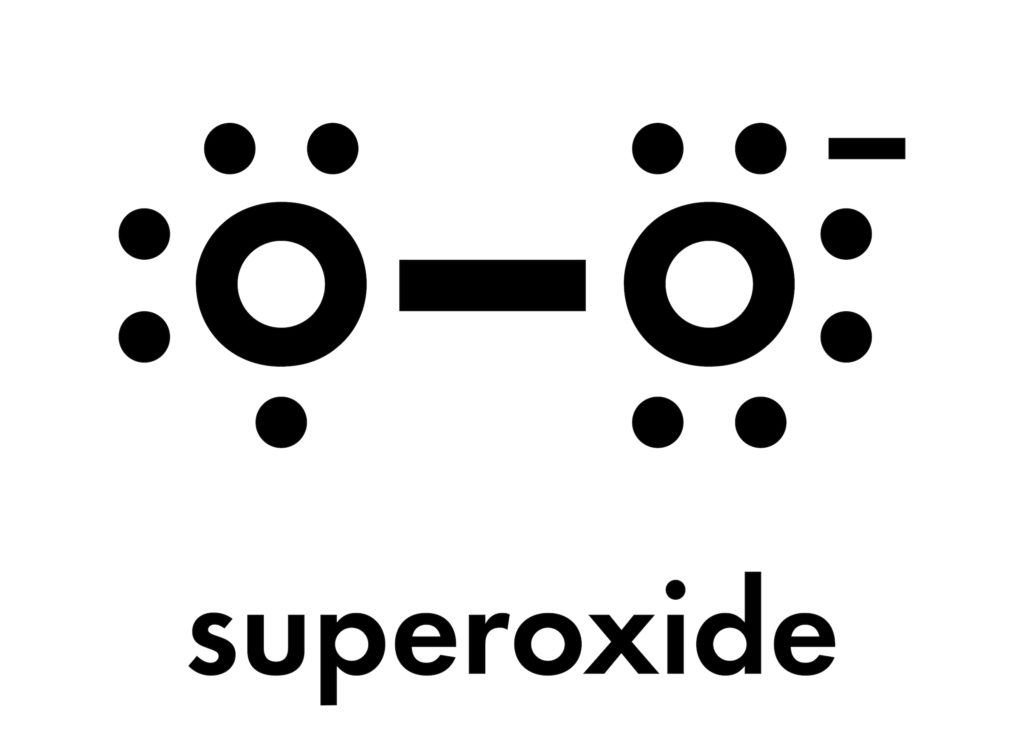
Superoxide – two oxygen atoms missing an electron, a routine byproduct of generating energy in the mitochondria of cells, and a destructive weapon used by macrophages against invading pathogens.
Antioxidants are molecules that have the ability to donate electrons to free radicals to stabilize them, “quenching” their destructive potential. They include relatively complex enzymes such as superoxide dismutase and catalase, but also simple compounds contained in food such as vitamins A, C and E, and phytonutrients including carotenoids and polyphenols.
By donating an electron antioxidant molecules and enzymes “reduce” free radicals, becoming “oxidized” themselves. However, unlike other molecules damaged by oxidation in the cell, they can remain stable and avoid setting off a chain reaction in the way that other molecules (such as fats) forced to give up electrons might do. If you want a way of remembering which of oxidation or reduction means the gain or loss of an electron this is a good mnemonic: it’s the phrase OIL RIG – oxidation is gain, reduction is loss.
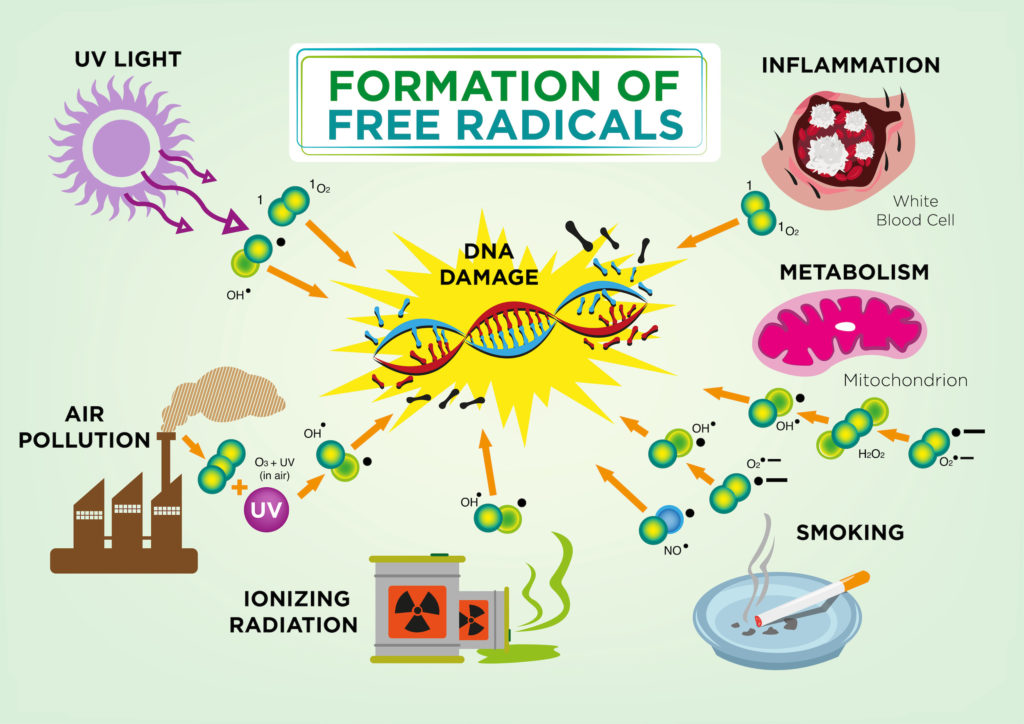
Free radicals are an inevitable part of life, damaging vital components of cells including DNA, putting us at risk of diseases including cancer.
The concentration of free radicals can be too great for our antioxidant capacity to soak up, with the result that the cells suffers “oxidative stress” in which carbohydrates, fats and proteins with important functions, and even the nucleic acids in DNA, can be harmed. This damage to cells accelerates the aging process and increases the risk of disease, including cardiovascular disease (which is greatly influenced by the oxidation of cholesterol-carrying proteins), Alzheimer’s disease, Parkinson’s disease, diseases of the eye including cataracts and macular degeneration, and genetic mutation and cancer.
Nurturing our antioxidant system, and reducing the odds it faces, is one of the main reasons for exercising more, sleeping better, reducing stress and improving our diets.
Our ancient inherited defenses – antioxidant enzymes
Interestingly a certain amount of free radical activity in cells is a good thing, stimulating cellular defenses and acting as a signaling system. However, left uncontrolled it would be deadly, and homo sapiens would not have survived but for the antioxidant machinery that has evolved with us.
This defensive system includes several enzymes (tiny protein machines) with the power to borrow and donate electrons to neutralize or change free radicals. They include superoxide dismutase which is deployed in cells to convert the highly reactive superoxide anion shown above into the less damaging hydrogen peroxide. Left to itself hydrogen peroxide could form the extremely harmful hydroxyl radical, but another enzyme, catalase, is able to convert it into water and stable oxygen.
Catalase is present in almost all other living organisms that are exposed to oxygen and is worth a slightly closer look, as it is central to our survival, fairly well understood, and typical of the way enzymes act as catalysts – physically holding atoms or molecules together for the fraction of a nanosecond required to make an essential chemical reaction happen. They undergo only very brief and instantly reversible change themselves, as we will see in catalase.
Catalase uses the same iron-containing heme structure that is present in red blood cells to neutralize two hydrogen peroxide molecules in a rapid two-stage process. Firstly, the enzyme “borrows” an electron from one of its iron atoms and donates it to a hydrogen peroxide molecule (H2O2), breaking it into water (H2O), and a single oxygen atom (O) which is kept fastened to the iron. In the next stage, the iron atom seizes back an electron from a second molecule of hydrogen peroxide, once again producing water and a second oxygen atom which is combined with the one already being held to be released as a stable oxygen molecule (O2) . The process is then instantly repeated on two more hydrogen peroxide molecules.
Combining the pair of reactions into one produces this chemical formula: 2 H2O2 → 2 H2O + O2.
The greater the concentration of hydrogen peroxide the more productive the enzyme, and it is capable of converting tens of millions of the molecules to water and oxygen every second. Catalase is usually concentrated in the liver and dropping hydrogen peroxide liquid onto fresh liver produces bubbles of oxygen. There’s enough catalase in blood for same effect to be seen on a bleeding cut.
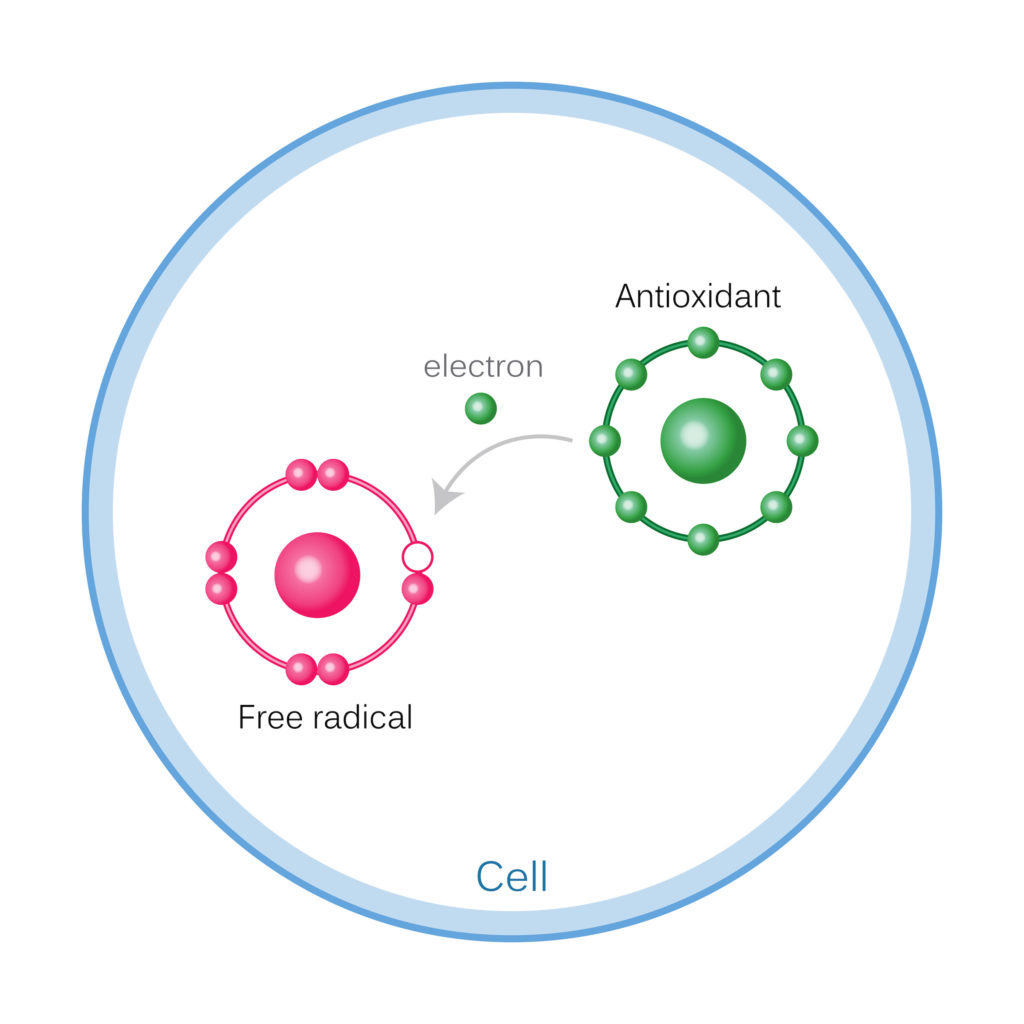
Atoms on antioxidants donate an electron to atoms on free radicals, stabilizing them and neutralizing their destructive potential.
Two other fascinating aspects of catalase are its role in preventing the graying of hair and the extra dose that allows termite queens to live longer. In the first case, hydrogen peroxide – which inhibits the coloring of hair by melanin – is thought to build up in hair follicles with age because of a decline in catalase production. In the second, it has been found that queens of the termite species Reticulitermes speratus have twice the catalase activity of worker and soldier termites, and that their longer life is the result of their greater antioxidant capacity.
How food quenches free radicals
Our very survival relies on obtaining sufficient vitamins in the diet, given the many vital functions they perform. For a handful of them – vitamins A, E and C – combating free radicals is part of their role. For example, vitamin E’s structure allows it to give up an electron to neutralize a free radical without itself becoming unstable. Vitamin C (also known as ascorbate) can then restore that electron, refreshing vitamin E molecules so they can repeatedly donate electrons to other unstable molecules. Vitamin C is also able to tolerate the loss of an electron without becoming a free radical itself and is harmlessly excreted in its depleted state and is gradually consumed.
Vitamins and minerals supplied in the diet are also essential for the production and operation of antioxidant enzymes. We’ve already mentioned superoxide dismutase, which plays a vital role in reducing the dangerous superoxide anion in cells. It needs manganese as a “cofactor” in order to function, a mineral that is, for example, plentiful in hazelnuts.
Another family of antioxidant enzymes are selenoproteins, which are made in the liver using selenium. Selenoprotein P is able to neutralize the powerful oxidant peroxynitrite. Peroxynitrite is itself formed by the pairing of the superoxide anion with the free radical nitric oxide, and although free radicals cease to be radicals after reacting with each other, peroxynitrite remains a powerful oxidizing agent.
Another selenoprotein, Glutathione peroxidase, is able to neutralize hydrogen peroxide and lipids in bodily tissues that have been damaged by oxidation. It acquires the electrons needed to “defuse” these toxic molecules from a readily available charged molecule called NADPH (Nicotinamide Adenine Dinucleotide Phosphate) and uses vitamin C as an electron-handling intermediary.
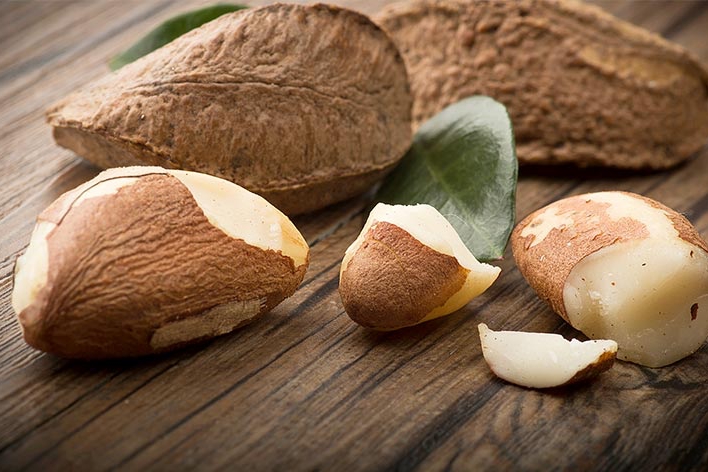
Brazil nuts contain extraordinary amounts of selenium; just one nut contains more than the average daily requirement
Research on Brazil nuts has illustrated how the consumption of particular foods can have a practical and measurable effect on health. A direct relationship has been established between the number of selenium-rich nuts consumed and the level of activity of glutathione peroxidase, and in turn the likelihood of disease. A single Brazil nut contains well over the recommended daily adult allowance of 55micrograms (mcg) and studies suggest that it’s enough to stimulate activity in glutathione peroxidase. This increased activity has been associated with a decrease in damage to DNA in obese women and a reduction in oxidative stress and inflammation in people with chronic kidney disease, suggesting a clear link between diet and health (see HealthSpan muesli recipe and notes).
Phytonutrients – chemical compounds made by plants to protect themselves
Existing alongside our existing antioxidant equipment, and the vitamins and minerals included in our diets, we have the phytonutrients we consume in plant food. They are sometimes referred to as phytochemicals, as their status as nutrients is not always clear, but these compounds, often contained in the pigments giving plants a wide range of bright or deep colors, are usually biologically active in the plant. They’ve been shown to have the ability to donate electrons to free radicals in largely laboratory (in vitro) and animal studies, but it’s generally not known which of their many different forms produce which specific effects or benefits.
This quick classification divides phytonutrients into carotenoids and polyphenols. Without being exhaustive, this summary includes some of the best known and most studied.
Carotenoids are divided into oxygen containing xanthophylls, including lutein (green vegetables) and zeaxanthin, and unoxygenated carotenes, including alpha-carotene, beta-carotene (carrots), and lycopene (tomatoes).
Polyphenols include phenolic acids (including the salicylic acid which is the basis of aspirin), lignans (the estrogenic phytonutrient found in flaxseed) and stilbenes (which include the red pigment resveratrol contained in red wine). However, by far the biggest group of polyphenols are flavonoids.
Flavonoids, like other polyphenol groups, share a basic chemical structure; in their case it is composed of two adjacent carbon rings and a third isolated from them. Depending on small variations in structure, flavonoids have different biological effects and can be divided into anthocyanidins (including those found in blueberries and other dark purple fruit and vegetables), chalcones, flavones, isoflavones (including from soy and garbanzo beans, and chickpeas), flavanones, isoflavones and flavanols (including the kaempferol and quercetin found in apples and onions), and flavonols (note the different spelling!).
Flavonols themselves constitute a sizable family, including proanthocyanidins, catechins and epicatechins (such as the epigallocatechin gallate found in green tea).
Phytonutrients are produced by plants to help them deal with stresses such as intense sunlight – which as we’ve seen has the capacity to create free radicals – and to resist fungi and other pathogens. They are also associated with a strong or bitter taste, reflecting their role protecting plants from attack by insects and grazing animals.
A quick look at the biological activities of flavonoids gives a sense of their varied protective role in plants. They shield plants from ultraviolet light, but also increase their resistance to drought and frost. As well as acting as electron-donating antioxidants, flavonoids help to carry chemical signals, defend against microbes and parasites, and neutralize toxins.
Phytonutrients can neutralize free radicals, but research on health outcomes is still limited
In the last few decades phytonutrients have emerged as an important element of “functional foods” or “neutraceuticals”. Thousands of individual compounds have now been identified and the literature about them is expanding rapidly. Numerous studies have confirmed that phytonutrients such as polyphenols can “scavenge” free radicals neutralize them and prevent damage to cells. Government bodies, such as the National Institutes of Health (NIH) and the Department of Agriculture (USDA) in the United States have played an important role in this kind of basic research, and recognized phytonutrients as “important determinants of human health” and acknowledged that consuming them in the diet is an “effective strategy” for reducing the risk of diseases connected with oxidation.
Apart from basic laboratory research, many studies have linked the consumption of phytonutrient-rich food – including fruit, vegetables, nuts, seeds and legumes – with a lower risk of cardiovascular disease, cancer and strokes. Patterns of food consumption such as the Mediterranean diet that are acknowledged to slow aging and reduce the risks of metabolic diseases (connected with the breaking down of food for energy) such as diabetes and fatty liver are characterized by their high content of such food. The same nutrients are conspicuously lacking in the “western” diet (high in sugar, saturated fat, salt and processed carbohydrates) which is associated with high rates of metabolic disease.
But compared to research on other elements of nutrition and metabolism, investigation of phytonutrients is in its infancy, with a lot of complicated detail still to be assessed. Laboratory based research has produced encouraging evidence for these plant compounds having biological activity in animals, but it has often focused on rats and mice rather than people or been limited to test tube experiments.

The Mediterranean diet is thought to lower the risk of metabolic disease; its high content of phytonutrients might be part of the reason.
Studies on food consumption by large populations has been observational, establishing links without proving causality. For example, as the NIH has pointed out, people who eat large amounts of fruit and vegetables might be expected to have lifestyles that are healthy in other ways, perhaps exercising more and not smoking, and it might be these behaviors that explain their lower risk of disease.
Populations who consume a lot of fruit, vegetables, nuts, legumes and whole grains, also get other huge benefits such as dietary fiber, with well-established benefits to health that might eclipse those of phytonutrients. Such diets, dominated by lightly-processed plant foods, are also likely to provide intense nutrition with relatively few calories, and without the negative effects on health of excessive sugar and saturated fat.
Could some research be biased?
It’s also worth looking carefully at the origin and funding of the research that is being carried out. Much of it is sponsored by food companies, which doesn’t in itself render it unreliable or misleading, but which has raised questions of unconscious bias. Leading figures in nutrition research have suggested that research can be set up so that it asks questions that suit its sponsors, perhaps establishing only a partial picture as a result.
There are all sorts of potential biases – from the selection of participants to the choice of physiological indicators and when they are tested – that can skew results. Papers that fail to show effects are less likely to be published, adding to the probability that the research literature as a whole will be misleading. Many of the most persuasive studies are reviews that combine the results from multiple studies, thus working on data from many thousands of people. If the research they are analyzing is skewed, the danger is that such reviews will magnify the bias.
Cocoa is just one example of a nutrient that has been the subject of copious research. This literature encompasses many aspects of cocoa, linking its consumption to the greater longevity of people living in some “blue zone” groups, and exploring its apparently considerable antioxidant potential in our own diets. Occasionally, the account revealed by studies, including those in peer-reviewed journals, turns out to be flawed or at least to have left important parts of the story untold. A considerable part of research on cocoa has been funded by the chocolate industry, whose sales have benefited from the enhanced reputation of chocolate as a health promoting food. Academics are obliged by reputable journals to note sources of funding, or reveal jobs as “expert advisors” in the industry, and it’s worth noting such acknowledgements at the end of a paper.
It’s also significant that governments and health authorities have remained extremely cautious about certifying the benefits of phytonutrient-containing foods, including chocolate. Pending firmer evidence for their ability to reduce disease food labeling regulations in Europe and the United States severely limit the claims that can be made for them.
Phytonutrients vary greatly in how accessible they are to our bodies
The way phytonutrients work in people is complex, and some exist in many different forms, more than two dozen in the case of the well-known anthocyanins of blueberries and other purple fruit. There are variations in how readily different antioxidants are absorbed, stored and used in tissues likely to benefit from them. This “bioavailability” might rely on the kind of matrix the rest of the food provides for the phytonutrient, or how it was metabolized. Some phytonutrients: for example, chocolate can limit the absorption of the catechins in green tea.
It’s been found that the bioavailability of the most common antioxidants in food, polyphenols, varies significantly so that their concentration in “target” tissues does not always match the amount in the diet. Data from almost a hundred studies of 18 common dietary polyphenols showed that isoflavones (in lentils, beans, especially soybeans) and gallic acid (from tea, cloves, vinegar, and fruit such as strawberries, grapes and bananas) were the best absorbed. They were followed by catechins (in tea, cocoa, prunes and broad beans), flavanones (citrus fruit) and quercetin glucosides (capers, buckwheat, radish, onions, watercress and kale). At the bottom of this list were proanthocyanidins (in cranberries, blueberries, grapes and elderberries) and the galloylated tea catechins (such as epigallocatechin gallate in green tea) and anthocyanins (in blueberries and other dark purple fruit).
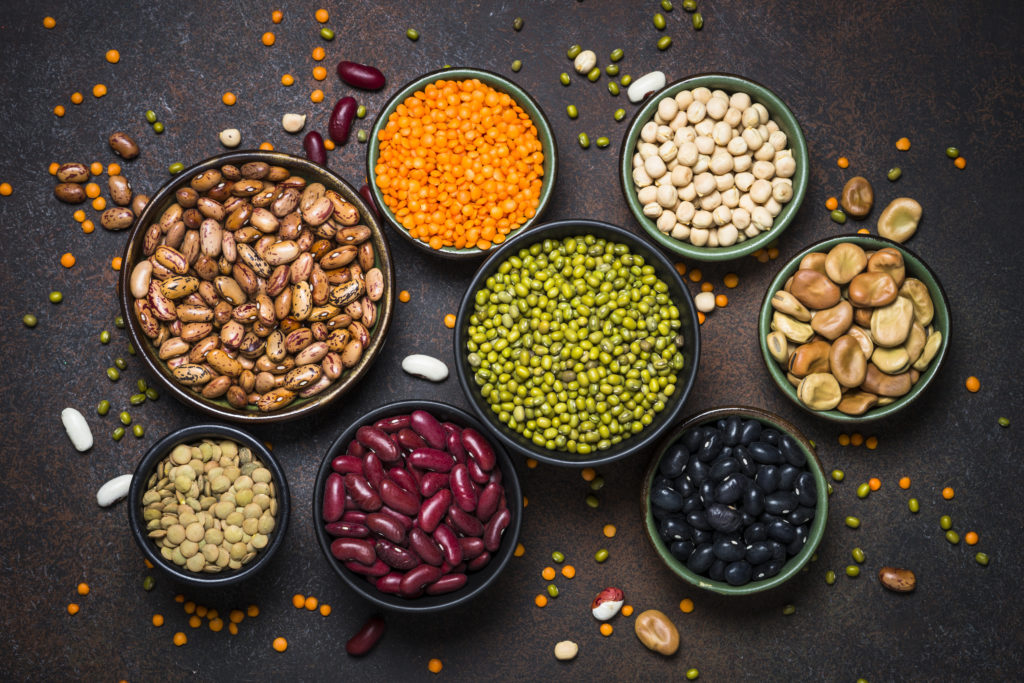
The isoflavones in lentils, beans and soybeans appear to be among the most readily absorbed phytonutrients.
One of these, proanthocyanidins – which varies only slightly in its chemical structure from the catechin, epicatechin, and the slightly more complex tannins, found in tea – relies on bacteria in the lower gut to convert it into more bioavailable forms. Only about 10% of proanthocyanidins are absorbed into the small intestine. Similarly, the absorption of quercetin from onions might be improved by the presence of fat and carbohydrate fiber, the latter because of its ability to stimulate the movement of the gut and encourage fermentation by bacteria.
Another slight complication in translating a particular food into antioxidant presence in the bloodstream lies in the differing concentration of phytonutrients within individual plants, and the possibility that they are more readily discarded. For example, the quercetin content of onions is considerably greater in the outer rings and near the root system than elsewhere. It’s worth knowing where the richest constituents of plants lie, in case we are discarding them by excessive scraping or peeling. Similarly, it’s worth bearing in mind that many antioxidants are degraded by boiling; steaming, baking and frying can preserve more of them. However, some of these compounds, such as lycopene in tomatoes and carotenes in carrots, are actually liberated by cooking and increase in bioavailability.
Phytonutrients might bring benefits beyond countering oxidation
Finally, it could be that the considerable effort to investigate the antioxidant capacity of phytonutrients is missing their real potential in the diet. Laboratory research has found evidence that as well as quenching free radicals polyphenols might modulate the complex system of chemical signaling inside cells that governs how they respond to hormones and other external messaging. They might even influence the way genes are “expressed”, their instructions copied and translated into functional proteins such as enzymes. Flavonoids – a subsection of polyphenols, but themselves a large family of phytonutrients – may be able to affect signaling in pathways used by hormones as central as insulin, and alter the behavior of critical enzymes controlling many cell functions. If further research bears out this role for polyphenols, it could give them at least as much impact as they might have as antioxidants alone.
How can we measure the antioxidant capacity of food?
Carotenoids, polyphenols, and various types of polyphenols including flavonoids and flavanols vary widely in their capacity to donate electrons, necessitating some way of measuring their antioxidant potential.
Among the methods developed are total antioxidant capacity (TAC) and total radical-trapping antioxidant parameters (TRAP) Two other mainstream measures – FRAP and ORAC – also offer interesting comparisons between foods.
FRAP is the ferric reducing capacity of plasma, and uses as its benchmark an artificial, water-soluble version of vitamin E called Trolox, which is used by biochemists to prevent or mitigate oxidative stress. It is used as a cheap and reliable way to record the concentration of electron-donating antioxidants and their cumulative effect. Measurements are expressed as millimoles per 100g of the food, millimoles being a measurement used in chemistry for large numbers of tiny entities.
FRAP records pecan nuts, one of the ingredients in HealthSpan muesli, as containing as much as 10.6 mmol of antioxidants per 100g (about 3.5oz), more than the 9.2 mmol of the famously antioxidant fruit blueberries or the 2.3mmol of raspberries. However, even pecans are some way short of dark chocolate. Chocolate high in cocoa solids (as opposed to other fats and sugar) contains an impressive 15mmol.
A different measure of antioxidant power of food – this one devised by the National Institutes of Health and Aging – is called ORAC (oxygen radical absorbance capacity). ORAC values are also expressed according to 100g of different foods, and official recommendations are for an intake of between 3,500 and 5,000 daily. The “five a day” fruit and vegetable consumption recommended as a minimum by the US and UK governments (among many others) would constitute around 3,500 ORAC units. 100g of raisins – not that you’d necessary want to eat so many, and there are far fewer in a serving of our muesli – would give you an ORAC score of 3,400.
This brief list of ORAC scores from the National Institute of Health provides a yardstick for understanding antioxidant content in fruit and vegetables. 100g constitutes slightly more than the “serving” (80g or half cup of cooked vegetables) envisaged by the “five-a-day” guidance.
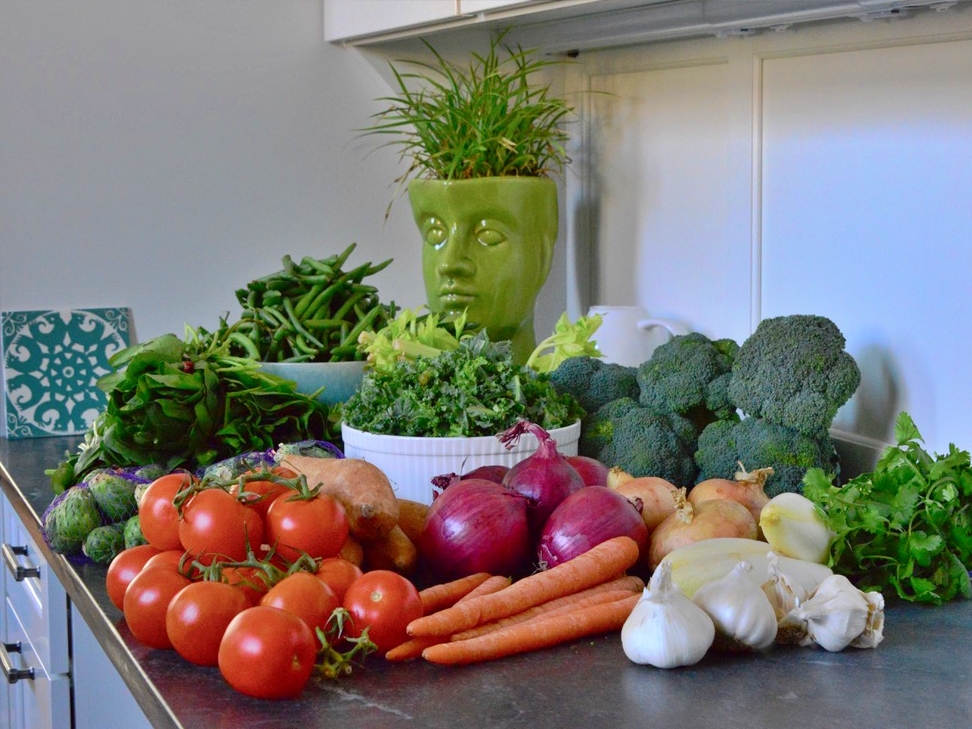
According to the ORAC system of measurement, the five-a-day recommended minimum intake of fruit and vegetables will provide around two-thirds of your antioxidant needs
Top-Scoring Fruits & Vegetables
ORAC units per 100 grams (about 3 ½ ounces)
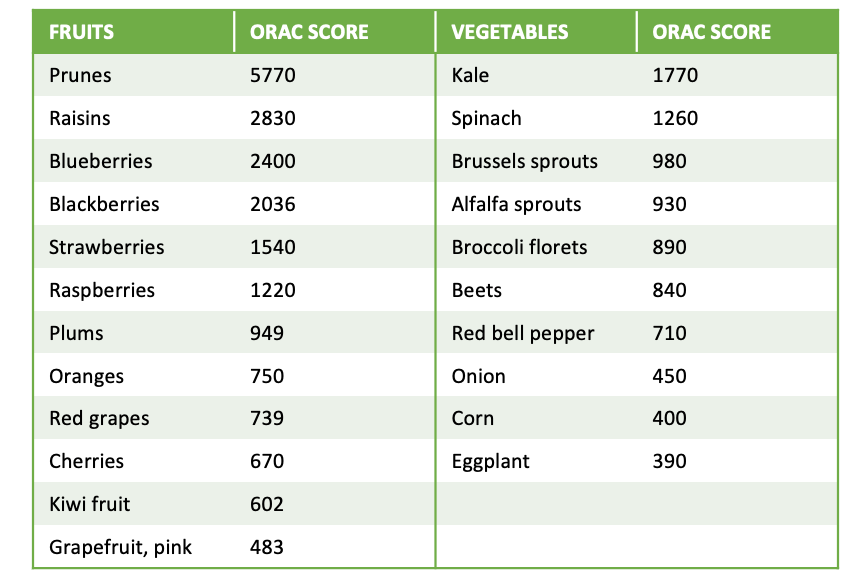
The interesting thing is that there is a limit to the antioxidant carrying capacity of the body, with an upper level of around 5,000 generally agreed. Much more than that is probably expelled in urine. It means that a rich and regular supply – in fruit, vegetables, nuts, seeds and grains – rather than huge doses in supplements makes much more sense and will provide more variety and a steadier intake. Another reason for augmenting your muesli and consuming calories in nutrient-dense form and not in nutrition-free sugar.
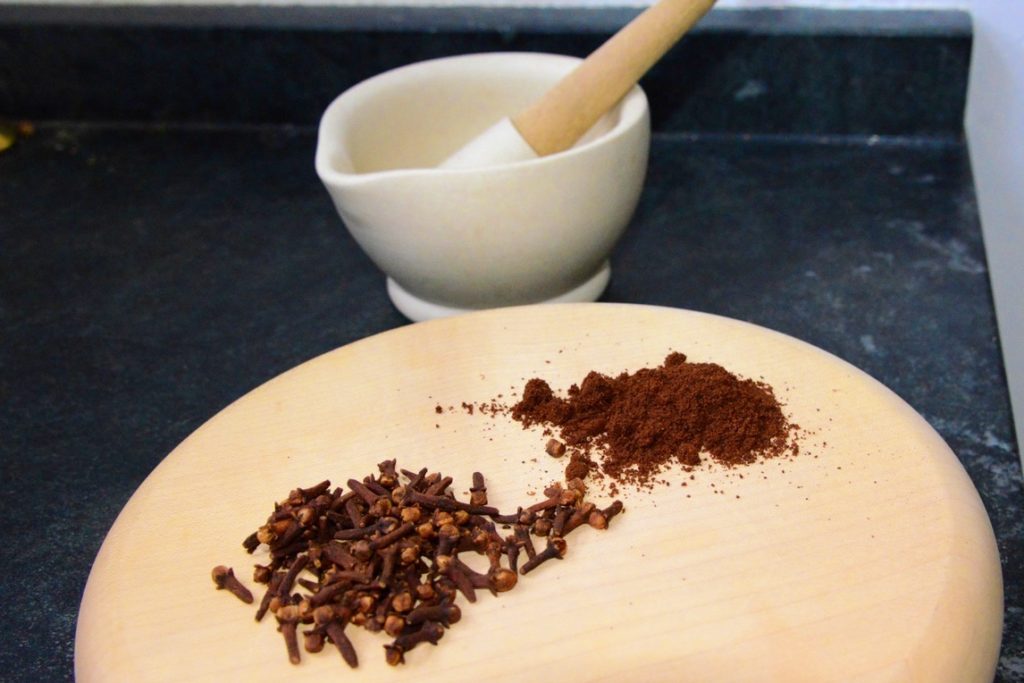
Cloves – at the top of the tree in their extraordinary concentration of antioxidants.
Some foods provide extraordinarily high ORAC values (they are extremely potent in their ability to “absorb” or neutralize oxygen radicals) – although the highest scores are from herbs and spices that are eaten in tiny quantities. Among the spices are ground cloves (314,446 per 100g), ground cinnamon (267,536), and ground turmeric (159,277). The herbs include peppermint (with an ORAC score of 13,978 per 100g) and oregano (13,970).
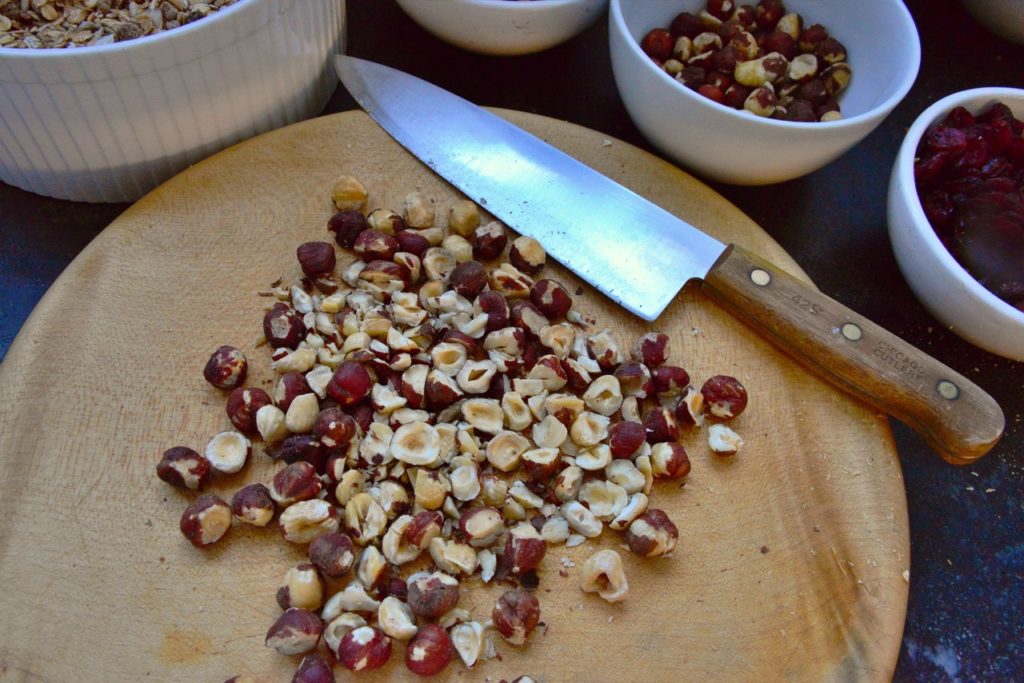
Hazelnuts have an ORAC score of 9,645 per 100g
Hazelnuts and cranberries – each of which are included in HealthSpan muesli – have scores of 9,645 and 9,584 per 100g respectively. Walnuts have a huge ORAC score of 13,541, although they are not included in the recipe partly because the plentiful short-chain omega 3 fat alpha-linolenic acid they contain is highly susceptible to oxidation once finely chopped. Cocoa, which has such a high FRAP antioxidant content, also has an extraordinarily high ORAC value – 80,933 per 100g of the powder.
Recognize phytonutrients by their color
Phytochemicals are found in the pigments that give plants their color, and those colors, and the depth and intensity of them, reveal the nature of the antioxidants they contain and sometimes how much of them too. These pigment compounds have been evolved by plants to protect them from the harsh environments (such as intense ultraviolet light in sunshine) and attacks from parasites, fungi and other pathogens. It’s one of the remarkable qualities of these foods that these benefits are to a great extent transferable to the people who eat them.
Here’s a very rough guide to how colors translate into benefits to health. I offer it a little hesitantly because it includes a tiny proportion of either phytonutrients or foods, and ignores the many factors complicating the conversion of antioxidants into tangible benefits in people. But perhaps it conveys a general idea of color reflecting phytonutrients, and the tangible benefits on health phytonutrients are considered to have, apart from their purely antioxidant function.
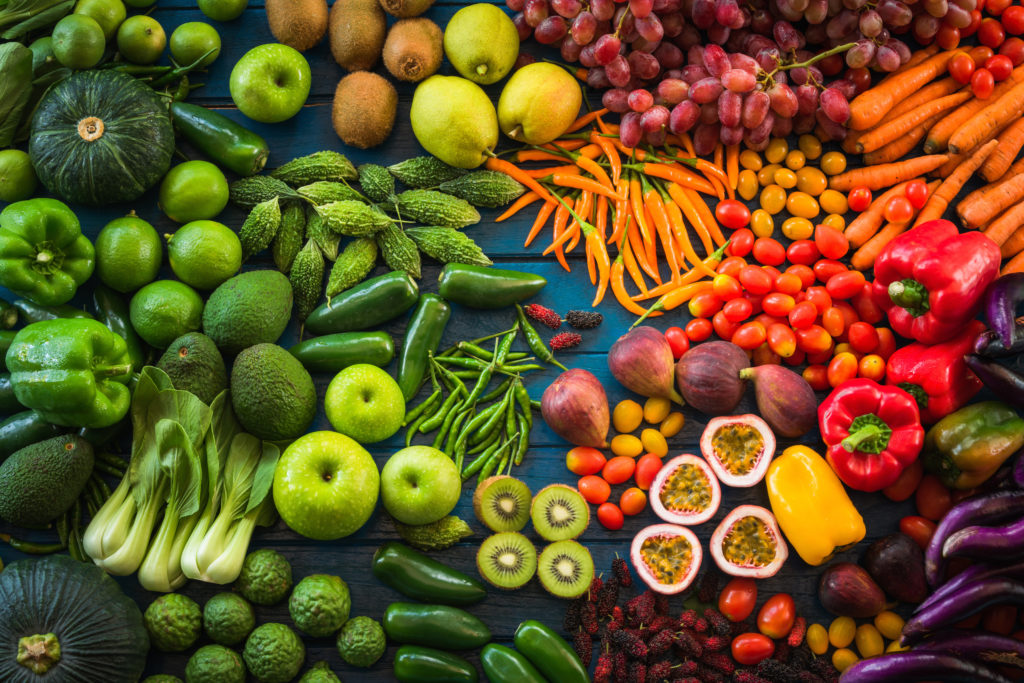
Bright and deep colors in fruit and vegetables indicate the type and richness of their antioxidant content.
Blueberries, blackberries, grapes, black beans, eggplant (aubergines), purple “red” cabbage etc., and dried fruit such as raisins and prunes.
Anthocyanins and other flavonoids
Believed to: slow the aging process and to protect memory, protect the heart from blood clots, guard against urinary tract infection.
Cherries, tomatoes, cranberries, strawberries, apples, beets, red grapes, red beans, watermelons.
Lycopene and other carotenoids, anthocyanidins (also in purple berries and fruit), resveratrol (grapes, peanuts)
Believed to: protect against some cancers, including of the prostate, promote heart and lung health and memory function, guard against urinary tract infections.
Carrots, yellow peppers, sweet potatoes, yellow and butternut squash, yellow beets, corn, etc., and fruit, oranges, grapefruit, cantaloupe, bananas, apricots, peaches; also, pineapple and mango but these are very rich in sugars.
Carotenoids including lutein, beta-carotene, beta-cryptothanxin
Believed to: promote the health of eyes (lutein), heart, skin and immune system, and (cryptothanxin) support cell signaling.
Broccoli, kale, spinach, cabbage, collard greens, green beans, green pepper, celery, asparagus, Brussels sprouts, zucchini, avocados, etc., fruit such as kiwi fruit, and green tea and green herbs – basil, thyme, mint, rosemary, sage, etc.
Sulforaphane, isocyanate, indoles, lutein, zeaxanthin, beta-carotene.
Believed to: protect vision (lutein, zeaxanthin), inhibit some cancers (sulforaphane, isocyanate), block carcinogens (indoles), protect against birth defects, maintain health of blood cells, bones and teeth.
Onions, garlic, leeks, cauliflower, radish, mushrooms, great northern beans, black-eyed peas, peanuts, etc., and fruit such as dates and figs.
Allicin, flavonoids (quercetin, kaempferol), isoflavones (almost exclusively the bean/lentil family)
Believed to: protect against some cancers (allicin, isoflavones), and guard against cardiovascular disease. Isoflavones, antimicrobial, anti-inflammatory.
Why not just take a supplement?
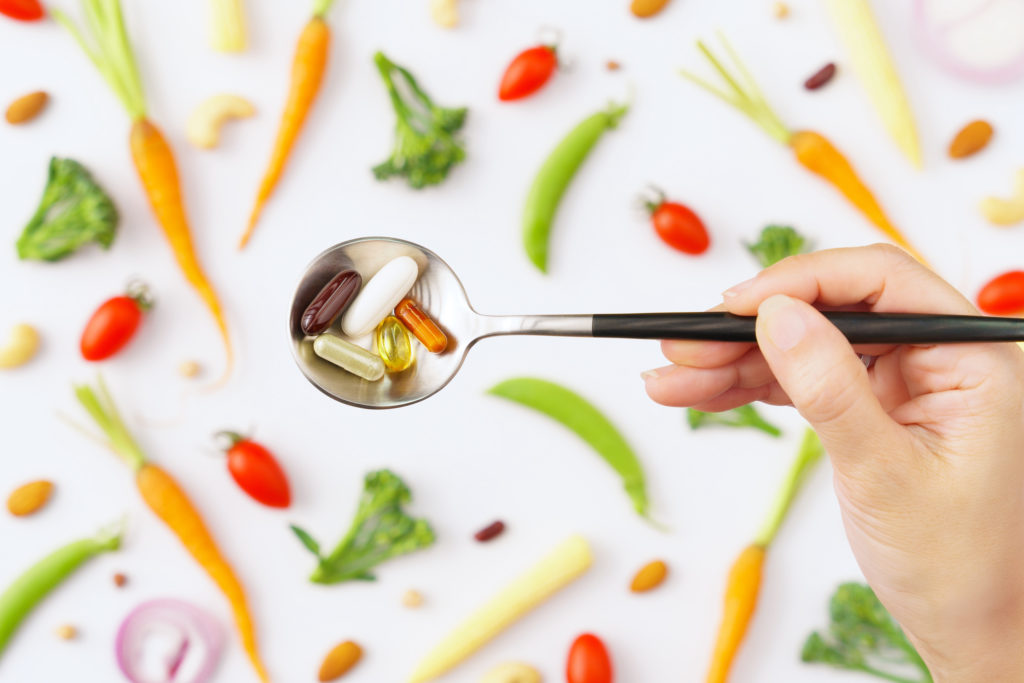
Supplements are a costly and not regulated by government – for most of us they are no substitute for healthy foods.
It occurs to many people that if elements in food – not least antioxidants – are beneficial, then taking more of them in supplements will be even more so. But for reasons that are so far not well understood, supplements appear less effective than the foods that include them in providing benefits to health.
Fruit, vegetables, legumes, seeds, nuts and whole grains also bring huge benefits that can’t be replaced by supplements. Perhaps the most important is carbohydrate fiber which is essential for gut health and nurturing the kind of beneficial gut bacteria that prevent pathogens taking over, and produce anti-inflammatory short-chain fats as well as other nutrients (see article, “We Have a Hundred Trillion Little Friends”). These basic plant-based foods also provide healthy unsaturated fats – the monounsaturated oleic oil in avocados and nuts for example – and protein in a form that’s low in cholesterol and saturated fat.
There are several other good reasons to avoid supplements and rely on a healthy diet.
1 Many supplements have not been proven to work
Because early tests of the antioxidant capacity of phytonutrients were so promising, many long-term trials have been carried out, many funded by government agencies such as the United States’ National Institutes of Health. According to the NIH in information published about ten years ago, “rigorous” tests including some 100,000 people largely failed to show that antioxidant supplements reduced the risk of cardiovascular disease, cancer and cataracts. (An interesting exception was the National Eye Institute’s Age-Related Eye Disease study, known as AREDS, which found that a combination of the antioxidant vitamins C and E, with beta-carotene and the mineral zinc, reduced advanced age-related macular degeneration by 25% in some people.)
Many studies (including those referred to in our antioxidant HealthSpan muesli) have established links between antioxidants in foods, their presence in tissues and improved capacity to stabilize or “defuse” free radicals. But these are contained in food rather than supplements.
2 Supplements may contain a different form of a nutrient
Antioxidants in supplements can have quite different chemical structures to their equivalents in food. Just to take one example, vitamin E is present in food in eight forms, whereas supplements commonly provide just one, alpha-tocopherol, with potential differences in the vitamin’s biological action.
3 High doses can be dangerous
The NIH warns that the high doses contained in some supplements far from being protective could be dangerous. Many of the principal trials tested vitamins and minerals rather than phytonutrients, but among them are studies linking high doses of beta-carotene to increased risk of prostate cancer and lung cancer in smokers. High doses of vitamin E have been associated with elevated risk of hemorrhagic stroke (the bleeding rather than blockage by clot form of stroke). Food sources provide antioxidants in small doses which might have different – and possibly more beneficial – effects in the bodies than high doses from supplements.
4 They can interfere with medicine
Supplements can change the way medicines work or how they are absorbed. For example, in high doses vitamin E has been shown to increase the risk of bleeding among people taking anticoagulants as a protection against clotting. Zinc supplements can interfere with the absorption of antibiotics such as quinolone or tetracycline, and reduce the amount of penicillamine – a drug for rheumatoid arthritis – that is absorbed.
5 The mixture of nutrients in food allows synergy in the way they work
Research on phytonutrients is relatively new to science, so the precise doses and combinations required to optimize health are unknown. Whereas a balance of several antioxidants with different functions can be obtained by a varied diet of fruit and vegetables, supplements tend to provide a dominant few. The mixture of antioxidants might in itself be important, with different compounds working together. For example, the proven ability of oats to reduce cholesterol absorption appears to rely on the contribution of several different phytonutrients.
Studies have identified other phytonutrients that appear to be more effective in combination than alone. One carried out on prostate cancer in rats suggested that combining tomato (which contains lycopene) with broccoli (sulforaphane, isocyanate and indoles) was particularly potent. The rats were fed broccoli and tomato separately or together for 22 weeks, and it was found that a combination of both (making up a total of 20% of their diet) brought about the greatest reduction (52%) in tumor growth. A lycopene supplement was less effective than whole tomatoes in reducing the weight of tumors.
6 Phytonutrients might be more bioavailable in food
Antioxidants might be better absorbed when carried in fruit and vegetables than in supplements. Bioavailability can be thought of as how easily the body can absorb a particular nutrient, and put it to effective use in target cells or tissue. It varies widely according to how foods containing antioxidants are stored, whether they’re subjected to heat and what food they are eaten with. Given this variability, and as we await more detailed research on compounds many of which have been identified only in the last two decades, a varied and balanced diet seems the best place to start in ensuring an adequate supply of each kind of antioxidant.
It’s clear that many nutrients are more bioavailable if eaten together, and they’re not always combined in supplements. The curcumin in turmeric is significantly more effective if eaten with black pepper (piperine). Evidence points to the ability of piperine to facilitate curcumin’s passage across the gut wall and to slow its breakdown by enzymes, particularly in the liver.
Vitamins E, D, A and K and phytonutrients in general are more easily absorbed when eaten with some fat. The effect of fat can be dramatic, even decisive. Among studies demonstrating the dose-dependent role of fat on phytonutrients, one experiment fed salads of spinach, carrots, tomatoes and romaine lettuce to volunteers with dressings containing zero, 6g or 28g of canola (rapeseed) oil. They found that in the absence of canola oil there was negligible absorption of either alpha or beta-carotenoids from the rich source contained in the salad, with significantly more absorbed into the bloodstream in the presence of low-fat dressing, and substantially more with the full 28g of fat.
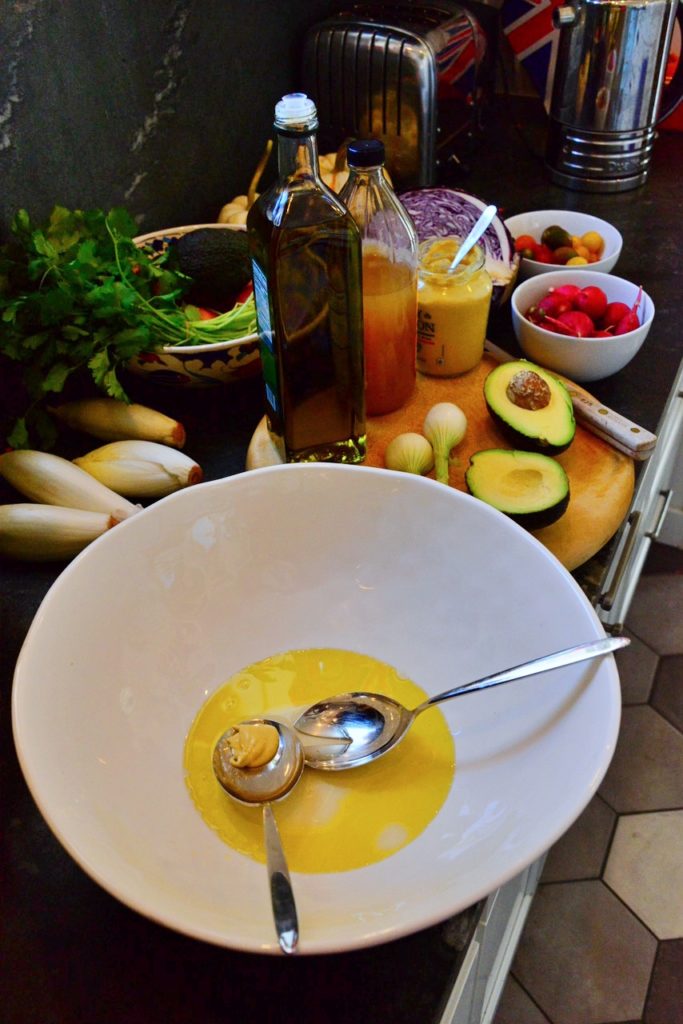
The fat in salad dressing dramatically improves absorption of antioxidants.
7 The supplements industry is unregulated
Finally, the multi-billion dollar supplements industry (more than half of American adults consume at least one dietary supplement isn’t regulated by the government, and there are reasons to think that you are often paying a lot without getting what you’re led to expect. In any event, it’s a lot to take so much on trust, when whole unprocessed foods are a sure and proven bet to improve your health and guard against disease.
An important exception: vitamin D
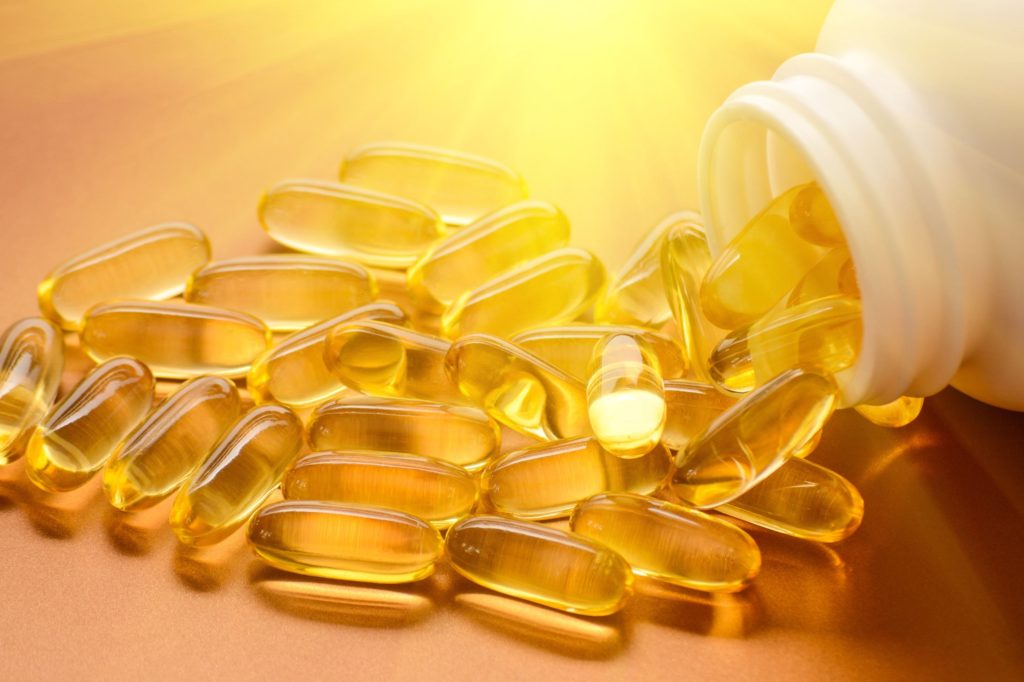
Everyone living north of 37 degrees latitude should consider taking extra vitamin D
These caveats do not mean that all supplements are redundant, but it is worth investigating their effects and side-effects and whether you need them, especially when they are costly and of unproven efficacy. I regularly take fish oil (for the long-chain omega 3 oils eicosapentaenoic acid – EPA – and docosahexaenoic acid – DHA), and turmeric (to counter inflammation), a couple of others periodically, and, every day from October to April, vitamin D.
I believe that everyone living north of 37 degrees of latitude should take vitamin D, or be sure that their levels of it are adequate, especially at this time of the Covid-19 pandemic. For a long period of the year the sunlight falling north of the 37thparallel is not strong enough to power the production of the vitamin D precursor in our skin. In the United States that line passes just south of San Francisco in California to Richmond, Virginia, and comfortably south of cities such as Denver and St Louis. It defines the southern borders of Utah, Nevada and Kansas. Elsewhere, north of 37 degrees of latitude includes almost all of Europe and Russia, and most of Turkey, Iran, and Japan.
It’s quite hard to get ample Vitamin D from food, so the lack of it during winter – or among people whose clothes largely cover their skin year-round – means that deficiency is not uncommon, and presents a significant health risk. Vitamin D has been shown – I believe beyond any reasonable doubt – to be an important safeguard against, respectively, your chances of being infected by the coronavirus, serious illness requiring a hospital stay, and death from Covid-19. Quite apart from Covid-19, vitamin D helps to moderate the immune system, making it an important anti-inflammatory nutrient, and guards against a number of diseases. But more about that another time!
